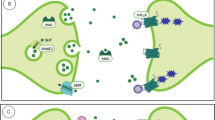Abstract
The study of serotonin (5-HT) receptors from the points of view of their anatomical localization and pharmacological characterization has been linked to the availability of highly selective radioligands exhibiting high affinity for their targets. This is particularly so in the case of serotonin receptors, since many different subtypes with overlapping pharmacological profiles have been described. Of these, the serotonin 5-HT1 receptor family appears to be the most complex in terms of molecular diversity and pharmacological properties. The lack of appropriate tools to characterize the different receptor subtypes included in this family has hampered progress in the understanding of biological function. In the case of serotonin 5-HT1D receptors all the radioligands used so far in their characterization behave as agonists from the functional point of view. This agonistic character is regarded as a disadvantage for radioligands since their interaction with the receptors under study depends on factors other than the abundance of the receptor, such as the coupling of the receptors with G-proteins. We describe here the binding properties of [3H]-GR-125743, a new radiolabelled derivative of a compound that exhibits selective antagonistic properties with respect to the serotonin human (h5-HT1D) and human (h5-HT1B) receptors. The compound has been characterized for its ability to label the cloned h5-HT1D and h5-HT1B receptors. The binding obtained in both cases was specific, saturable and reversible, whereas the percentage of specific binding depended on the level of expression of the receptors. Using saturation analysis we have found that, on the specific clones used in this study, the compound labels a receptor population 5 to 10–fold higher that the one revealed using [3H]-5-carboxamidotryptamine, a compound with agonist properties for these receptors in functional assays. Using [3H]-GR-125743 as a radioligand we have characterized the pharmacological profile of the same cloned h5-HT1D and h5-HT1B receptor preparations for a range of serotonin reference compounds by means of displacement assays.The affinities found have been compared, using regression analysis, with those obtained for the same radioligand and compounds in membranes obtained from human substantia nigra, a tissue known to be rich in h5-HT1B/1D receptors. We have found a better correlation, both in terms of correlation coefficient and of slope, between the substantia nigra data and the h5-HT1B data compared with the h5-HT1D data (0.94 and 1.05 vs. 0.86 and 0.64 respectively). Finally, the addition of 100μM GTP reduced the binding of [3H]-GR-125743 to h5-HT1D and h5-HT1B receptor subtypes by approximately 20% without affecting the affinities obtained for different displacers. Therefore, [3H]-GR-125743 appears to be a suitable radioligand for the characterization of h5-HT1D and h5-HT1B receptor subtypes, being potentially more useful than previously existing compounds.
Similar content being viewed by others
Author information
Authors and Affiliations
Additional information
Received: 13 February 1997 / Accepted: 18 May 1997
Rights and permissions
About this article
Cite this article
Doménech, T., Beleta, J. & Palacios, J. Characterization of human serotonin 1D and 1B receptors using [ 3H]-GR-125743, a novel radiolabelled serotonin 5HT1D/1B receptor antagonist. Naunyn-Schmiedeberg's Arch Pharmacol 356, 328–334 (1997). https://doi.org/10.1007/PL00005058
Issue Date:
DOI: https://doi.org/10.1007/PL00005058




